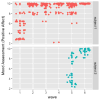A 3-level Bayesian mixed effects location scale model with an application to ecological momentary assessment data
- PMID: 29484693
- PMCID: PMC5980691
- DOI: 10.1002/sim.7627
A 3-level Bayesian mixed effects location scale model with an application to ecological momentary assessment data
Abstract
Ecological momentary assessment studies usually produce intensively measured longitudinal data with large numbers of observations per unit, and research interest is often centered around understanding the changes in variation of people's thoughts, emotions and behaviors. Hedeker et al developed a 2-level mixed effects location scale model that allows observed covariates as well as unobserved variables to influence both the mean and the within-subjects variance, for a 2-level data structure where observations are nested within subjects. In some ecological momentary assessment studies, subjects are measured at multiple waves, and within each wave, subjects are measured over time. Li and Hedeker extended the original 2-level model to a 3-level data structure where observations are nested within days and days are then nested within subjects, by including a random location and scale intercept at the intermediate wave level. However, the 3-level random intercept model assumes constant response change rate for both the mean and variance. To account for changes in variance across waves, as well as clustering attributable to waves, we propose a more comprehensive location scale model that allows subject heterogeneity at baseline as well as across different waves, for a 3-level data structure where observations are nested within waves and waves are then further nested within subjects. The model parameters are estimated using Markov chain Monte Carlo methods. We provide details on the Bayesian estimation approach and demonstrate how the Stan statistical software can be used to sample from the desired distributions and achieve consistent estimates. The proposed model is validated via a series of simulation studies. Data from an adolescent smoking study are analyzed to demonstrate this approach. The analyses clearly favor the proposed model and show significant subject heterogeneity at baseline as well as change over time, for both mood mean and variance. The proposed 3-level location scale model can be widely applied to areas of research where the interest lies in the consistency in addition to the mean level of the responses.
Keywords: Bayesian sampling; ecological momentary assessment; mixed effects; variance modeling.
Copyright © 2018 John Wiley & Sons, Ltd.
Figures



References
-
- Shiffman S, Stone AA, Hufford MR. Ecological momentary assessment. Annual Review of Clinical Psychology. 2008;4:1–32. - PubMed
-
- Ebner-Priemer UW, Trull TJ. Ecological momentary assessment of mood disorders and mood dysregulation. Psychological Assessment. 2009;21(4):463–475. - PubMed
-
- Stone AA, Shiffman S. Ecological momentary assessment (ema) in behavioral medicine. Annals of Behavioral Medicine. 1994;16(3):199–202.
Publication types
MeSH terms
Grants and funding
LinkOut - more resources
Full Text Sources
Other Literature Sources
